Neglected tropical diseases: survey and geometry of randomised evidence
- PMID: 23089149
- PMCID: PMC3478233
- DOI: 10.1136/bmj.e6512
Neglected tropical diseases: survey and geometry of randomised evidence
Abstract
Objective: To assess the quantity and distribution of evidence from randomised controlled trials for the treatment of the major neglected tropical diseases and to identify gaps in the evidence with network analysis.
Design: Systematic review and network analysis.
Data sources: Cochrane Central Register of Controlled Trials and PubMed from inception to 31 August 2011.
Study selection: Randomised controlled trials that examined treatment of 16 neglected tropical diseases or complications thereof published in English, French, Spanish, Portuguese, German, or Dutch.
Results: We identified 971 eligible randomised trials. Leishmaniasis (184 trials, 23,039 participants) and geohelminth infections; 160 trials, 46,887 participants) were the most studied, while dracunculiasis (nine trials, 798 participants) and Buruli ulcer (five trials, 337 participants) were least studied. Relative to its global burden of disease, lymphatic filariasis had the fewest trials and participants. Only 11% of trials were industry funded. Either a single trial or trials with fewer than 100 participants comprised the randomised evidence for first or second line treatments for Buruli ulcer, human African trypanosomiasis, American trypanosomiasis, cysticercosis, rabies, echinococcosis, New World cutaneous leishmaniasis, and each of the foodborne trematode infections. Among the 10 disease categories with more than 40 trials, five lacked sufficient head to head comparisons between first or second line treatments.
Conclusions: There is considerable variation in the amount of evidence from randomised controlled trials for each of the 16 major neglected tropical diseases. Even in diseases with substantial evidence, such as leishmaniasis and geohelminth infections, some recommended treatments have limited supporting data and lack head to head comparisons.
Conflict of interest statement
Competing interests: Both authors have completed the ICMJE uniform disclosure form at
Figures



References
-
- Hotez PJ, Molyneux DH, Fenwick A, Kumaresan J, Sachs SE, Sachs JD, et al. Control of neglected tropical diseases. N Engl J Med 2007;357:1018-27. - PubMed
-
- Hotez PJ, Fenwick A, Savioli L, Molyneux DH. Rescuing the bottom billion through control of neglected tropical diseases. Lancet 2009;373:1570-5. - PubMed
Publication types
MeSH terms
Substances
Grants and funding
LinkOut - more resources
Full Text Sources
